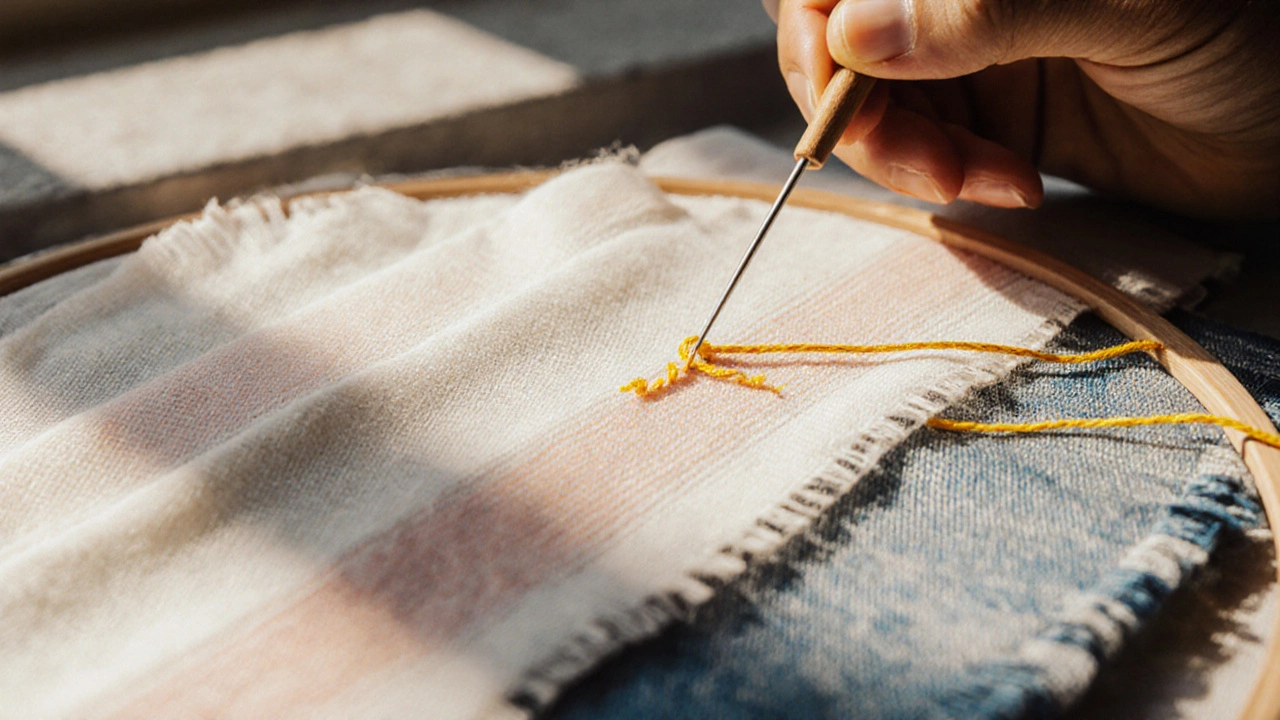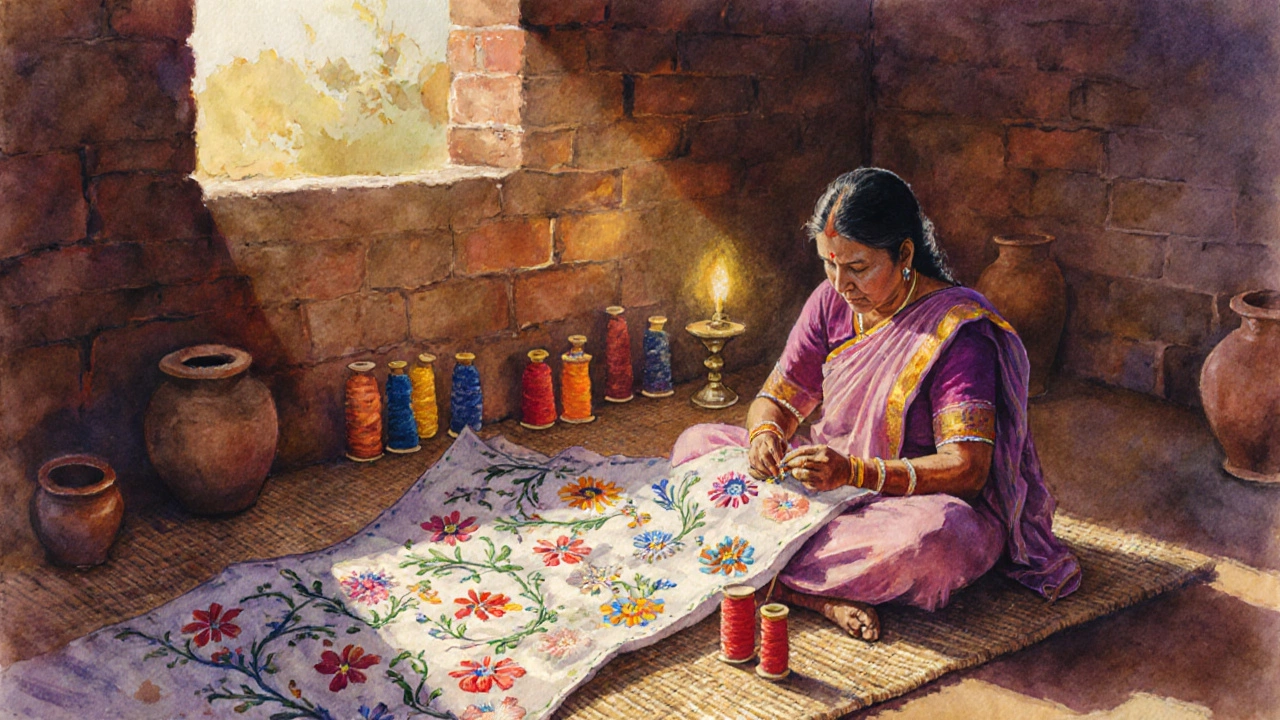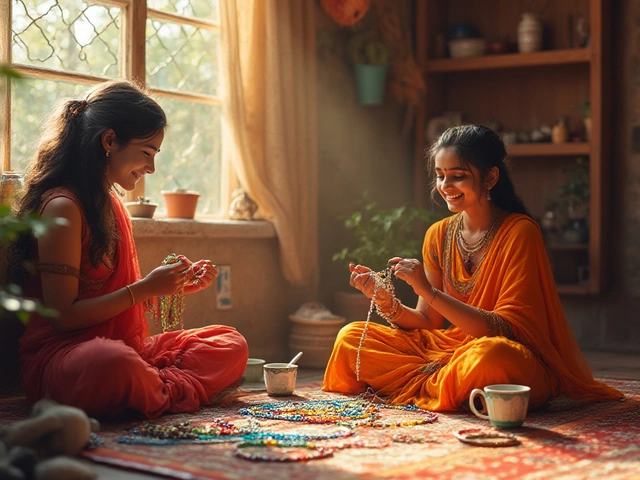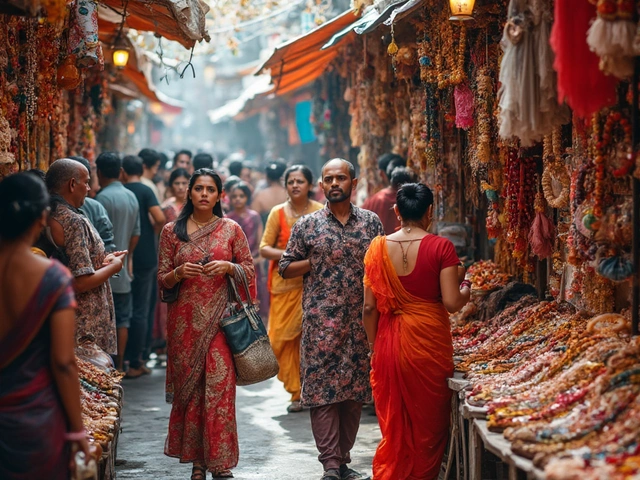
Kantha Fabric Comparison Tool
| Attribute | Kantha Fabric | Regular Cotton | Muslin |
|---|---|---|---|
| Primary Material | Cotton (reclaimed) | New cotton | Fine cotton |
| Stitching Technique | Hand-embroidered kantha stitch | None or machine-sewn | None |
| Texture | Soft, slightly textured | Smooth, uniform | Very lightweight, sheer |
| Typical Uses | Sarees, stoles, quilts, décor | Apparel, linens | Summer garments, scarves |
| Durability | High – layers reinforce each other | Moderate | Low – prone to tearing |
Select a fabric attribute to compare how Kantha fabric differs from regular cotton and muslin:
Quick Takeaways
- Kantha fabric is a lightweight, hand‑embroidered cotton textile rooted in Bengali tradition.
- It’s made from reused cotton sarees or shawls, stitched together with the distinctive kantha stitch.
- Typical uses include sarees, stoles, quilts, and home‑decor items.
- Care: hand wash in cold water, avoid harsh detergents, and air‑dry flat.
- When buying, look for authentic hand‑stitched patterns and natural cotton fibers.
What Is Kantha Fabric?
Kantha fabric is a lightweight, hand‑embroidered cotton textile that originates from the Bengal region of South Asia. The word “kantha” comes from the Bengali verb “kanta,” meaning to stitch, and the fabric’s signature feature is the running, satin‑like stitch that creates intricate patterns across its surface.
The material is usually crafted from old cotton sarees, shawls, or blankets. Artisans cut these garments into strips, layer them, and stitch the layers together using the kantha stitch. The result is a soft, slightly textured fabric with a lived‑in look that only improves with each wash.
Core Materials Behind Kantha
Traditional kantha relies almost entirely on cotton. The cotton fibers come from a variety of regional sources, but the most common are:
- Cotton - provides breathability and durability, essential for everyday wear in humid climates.
- Muslin - sometimes blended in for a finer hand feel, especially in premium stoles.
Because the base fabrics are often reclaimed garments, each kantha piece carries a history: faded motifs, slight wear, and occasional dye stains that become part of the design.

How the Kantha Stitch Works
The kantha stitch is a simple running stitch, but when repeated in tight rows it creates a dense, decorative texture. Artisans typically use a needle and a strong cotton thread, often dyed with natural colors like indigo, red ochre, or turmeric.
Steps to create a kantha panel:
- Collect several old cotton sarees or shawls.
- Trim them to uniform width (usually 12-18inches).
- Layer the strips; the bottom layer is the base, and the top layers add color contrast.
- Start stitching at one edge, pulling the needle through each layer and securing the thread after every 2-3cm.
- Continue the running stitch across the entire panel, creating a repetitive, wave‑like pattern.
- Finish by knotting the thread securely and trimming excess fabric.
The stitch not only holds the layers together but also adds decorative motifs-flowers, vines, geometric shapes-that are iconic to Bengali textile art.
Regional Roots: West Bengal and Bangladesh
Kantha’s cultural heart beats in two neighboring regions:
- West Bengal (India) - where the craft is tied to rural women’s cooperatives and seasonal festivals.
- Bangladesh - where kantha quilts, known as “nakshi kantha,” often tell stories through embroidered scenes.
In both areas, the craft is passed down through generations, with each village developing its own signature motifs and color palettes.
Common Uses of Kantha Fabric
Because kantha is soft, breathable, and visually striking, it’s employed in a range of products:
- Sarees - lightweight kantha sarees are perfect for summer weddings and festivals.
- Stoles and scarves - the stitch adds texture that works well with both casual and formal outfits.
- Quilts - “nakshi kantha quilts” are layered blankets featuring narrative embroidery.
- Home décor - cushion covers, table runners, and wall hangings bring a touch of Bengali heritage to interiors.
- Fashion accessories - bags, headbands, and even contemporary shoes incorporate kantha panels for an artisanal vibe.
How to Care for Kantha Pieces
Despite its rustic origins, kantha fabric can last decades if handled right. Follow these guidelines:
- Hand‑wash in cold or lukewarm water using a mild detergent.
- Avoid bleach; it can weaken the cotton fibers and fade natural dyes.
- Gently rub stained areas rather than scrubbing, to preserve the stitch integrity.
- Rinse thoroughly and press with a low‑heat iron on the reverse side.
- Air‑dry flat, away from direct sunlight, to prevent fading.
Because the fabric is often layered, it can tolerate a bit of rough handling, but the delicate threadwork benefits from gentle treatment.

Buying Guide: Spotting Authentic Kantha
When shopping online or at a market, keep an eye on these tell‑tale signs of genuine, hand‑crafted kantha:
- Irregular stitch spacing - machine‑stitched replicas are perfectly uniform.
- Variations in thread color - natural dyes produce subtle shades, while synthetic dyes look overly bright.
- Visible fabric edges - reclaimed cotton often shows frayed edges that are left untouched.
- Made‑in labels that reference West Bengal, Nadia, or Bangladesh.
- Artisan or cooperative branding - many NGOs certify fair‑trade kantha.
Price range varies: a plain kantha stole may start around $30USD, while a hand‑embroidered quilt can exceed $200USD, reflecting the labor intensity.
Kantha vs. Other Cotton Textiles
| Attribute | Kantha Fabric | Regular Cotton | Muslin |
|---|---|---|---|
| Primary Material | Cotton (reclaimed) | New cotton | Fine cotton |
| Stitching Technique | Hand‑embroidered kantha stitch | None or machine‑sewn | None |
| Texture | Soft, slightly textured | Smooth, uniform | Very lightweight, sheer |
| Typical Uses | Sarees, stoles, quilts, décor | Apparel, linens | Summer garments, scarves |
| Durability | High - layers reinforce each other | Moderate | Low - prone to tearing |
Future Trends: Modern Takes on Kantha
Designers worldwide are remixing kantha for contemporary markets. Expect to see:
- Hybrid pieces that combine kantha panels with denim or silk.
- Digital prints that mimic the kantha stitch for mass production.
- Eco‑friendly collections that emphasize the fabric’s up‑cycling roots.
- Collaborations between rural cooperatives and high‑end fashion houses, bringing authentic kantha to runway shows.
These trends keep the tradition alive while offering new revenue streams for artisans.
Frequently Asked Questions
Is kantha fabric the same as a regular cotton fabric?
No. While both are made from cotton, kantha fabric is distinguished by its hand‑embroidered stitch that binds multiple layers together, giving it a unique texture and visual appeal.
Can I wash my kantha saree in a washing machine?
It’s safest to hand‑wash in cold water. If you must use a machine, select a delicate cycle, place the saree in a mesh bag, and skip the spin‑dry to protect the stitching.
Where do authentic kantha products come from?
Most authentic pieces are produced in rural communities of West Bengal (India) and Bangladesh, especially in districts like Nadia, Murshidabad, and Rangpur.
How much does a hand‑embroidered kantha quilt typically cost?
Prices range widely based on size and complexity, but a medium‑size quilt often falls between $120USD and $250USD.
Can kantha fabric be used for outdoor clothing?
Kantha is breathable and lightweight, making it comfortable for indoor and mild outdoor wear, but it’s not ideal for heavy rain or extreme weather.


